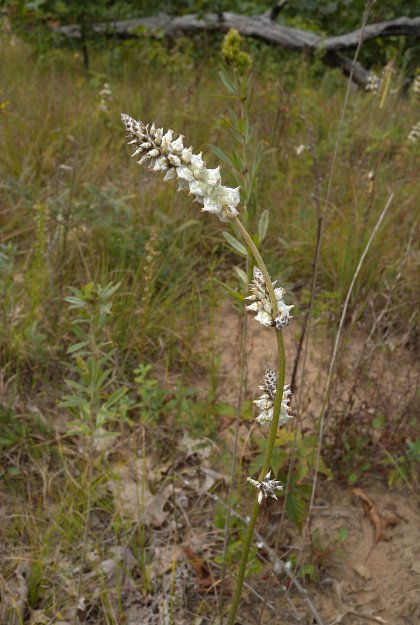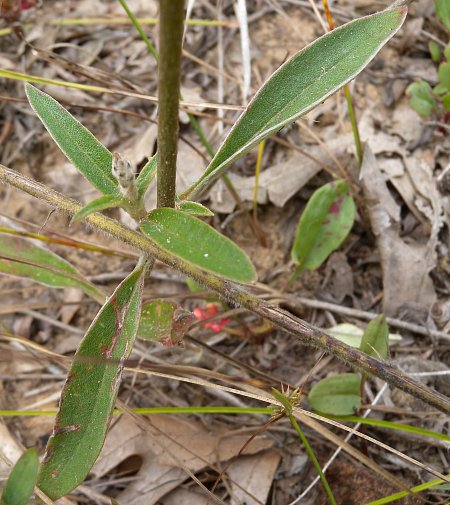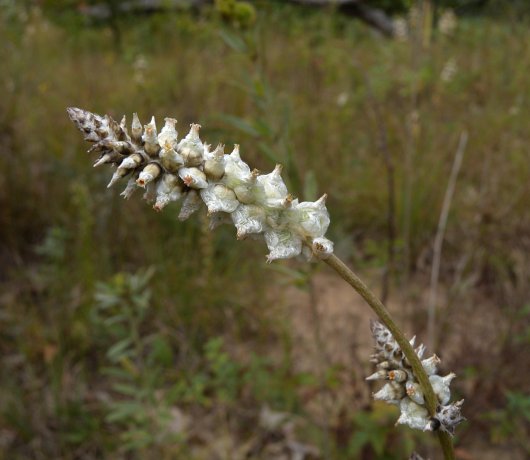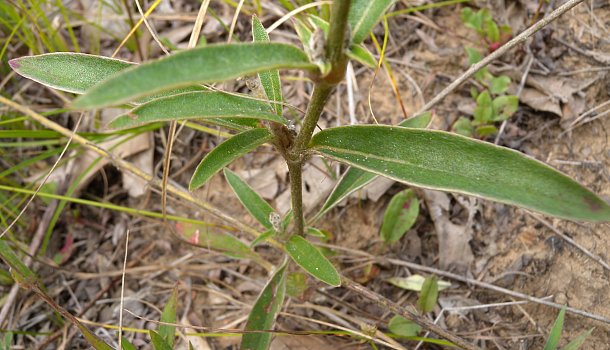Description: This wildflower is a summer annual about 1½–3' tall that is either unbranched or very sparingly branched. The central stem is erect, stout, terete, and covered with fuzzy hairs that are white, gray, or brown. Opposite leaves occur along the lower one-third of the stem. The leaves are up to 4" long and ¾" across. They are narrowly elliptic to elliptic or narrowly oblanceolate to oblanceolate in shape; their margins are smooth. At the base, the leaves are sessile or they have short petioles; their outer tips are blunt. The upper leaf surface is medium green, white along the margins, and sparsely covered with silky hairs. The lower leaf surface is pale green and more densely covered with silky hairs. The central stem is slightly swollen and reddish at the bases of the opposite leaves. The central stem terminates in a spike of flowers about 1½–4" long and there are usually 1-3 lateral spikes of flowers that are either sessile or on short peduncles. These lateral spikes are usually shorter in length than the terminal spike.

The terminal spike and its peduncle often lean to one side toward the apex of the plant. Each spike is densely packed with white woolly flowers that are arranged in 5 spirals (if the spike is long enough to determine this). Individual flowers are initially conical in shape, but they soon swell to become shaped like a short vase with a short narrow neck. The exterior of the flower is dominated by a white woolly calyx that is about 4-6 mm. long and across at maturity. The calyx has 5 tiny teeth at its apex that are cream-colored or pink. Inserted within the apex of the calyx are 5 stamens and a style; there are no petals. The filaments of the stamens are joined together to form an inner tubular structure that contains the ovary (or seed capsule). The blooming period occurs from mid-summer to early fall and lasts 2-3 months. Each flower matures into a single-seeded cottony fruit that often develops a pair of crests along its lower sides. A crest consists of a succession of dentate teeth. The cottony fruits are blown about by the wind. The seeds are 1.0–1.5 mm. long, ovoid, somewhat flattened, and brown. The root system consists of a taproot. This wildflower reproduces by reseeding itself.

Cultivation:
The
preference is full sun, dry conditions, and sandy soil with sparse
ground vegetation. Gravelly soil is also tolerated.
Range & Habitat:
The Large Cottonweed is occasional in sandy areas of NE Illinois and
the western half of the state, where it is native; elsewhere, this
plant is uncommon or absent (see Distribution
Map). Habitats consist of sandy hill prairies, dry sand
prairies, sand dunes, sunny open areas in sandy savannas, sandy fields,
areas along sandy paths, and sandy or gravelly areas along railroads.
To some extent, Large Cottonweed has extended its range along
railroads. Disturbed areas are preferred. Occasional wildfires are
probably beneficial in reducing the encroachment of herbaceous
perennials and woody vegetation.

Faunal
Associations:
Information about floral-faunal relationships for this species is
sparse. The flowers are probably wind-pollinated or self-fertile,
rather than insect-pollinated. The thrips, Haplothrips
malifloris, feeds on the leaves of Large Cottonweed and
similar species. It is possible that the toothed fruits can cling to
the fur of mammals or the feathers of birds, but this has not been
well-documented. If it is true, such animal-mediated dispersal would
help to spread the seeds into new areas.
Photographic Location:
A sunny area near a sandy path at the Hooper Branch Savanna Nature
Preserve in Iroquois County, Illinois.

Comments: This strange-looking wildflower immediately catches one's attention when it is encountered while in bloom or in fruit. The floral spikes are exceptionally white and cottony. The only other species in this genus that can be found in Illinois is Froelichia gracilis (Slender Cottonweed), which is probably adventive from the region of the Southern Plains. It is similar in appearance to Large Cottonweed, but less showy. Slender Cottonweed differs from Large Cottonweed by its shorter height (less than 2' tall), more slender leaves (less than ½" across), and shorter floral spikes (1½" or less). It also tends to branch more at the base, producing sprawling stems. Species in this genus are also referred to by the somewhat ominous name, 'Snakecotton.' Thus, Froelichia floridana is sometimes referred to as 'Plains Snakecotton.'